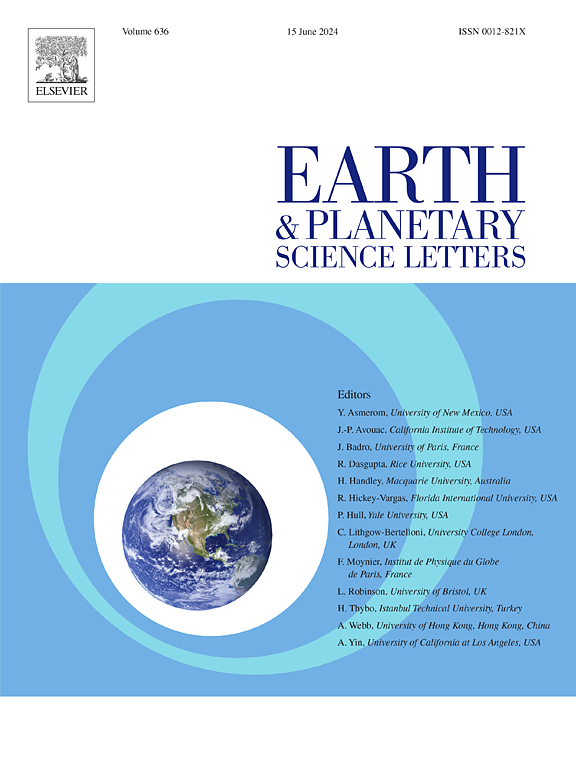Dynamics of Venusian rifts and their interactions with plumes and intrusions
IF 4.8
1区 地球科学
Q1 GEOCHEMISTRY & GEOPHYSICS
引用次数: 0
Abstract
The surface of Venus features extensive rift zones, known as chasmata, up to 10,000 km in length. Many of Venus' rifts exhibit intersecting branches, multiple troughs, and associations with coronae, which are often interpreted as small-scale mantle upwellings. With no Earth-like plate tectonics, the driving forces and rates of extension and lithospheric structure are poorly constrained. Here, we present the first 3D numerical models of rift tectonics under Venus-like conditions. We investigate the impact of crustal rheology (wet vs. dry diabase) and the thickness of the crust and lithosphere on rift geometry, topography, and surface fracturing. We further explore interactions between evolving rift structures and thermal upwellings (plumes) and magmatic intrusions – key components of Venus' global geodynamics. We find that rift morphology is highly sensitive to crustal rheology and lithospheric properties, with five modes of rift morphologies predicted: (1) narrow, (2) multiple, (3) wide-troughs, (4) wide-valley, and (5) branching; the multiple, wide-troughs, and branching modes align most closely with Venus observations. Underplated thermal plumes induce lower-crustal intrusions and cause localized lithospheric weakening, narrowing the rift regionally. Many coronae located within chasmata display arcuate trenches and may require alternative mechanisms or conditions to explain their rift morphology. Lateral offsets of rift valleys, branching from a single rift into multiple, and multiple parallel rift valleys are promoted by a relatively weak crust (wet diabase) or a strong crust (dry diabase) combined with a thin, warm lithosphere. If Venus' crust follows a dry diabase rheology, a significantly warm and thin lithosphere is required to reproduce observed rift characteristics. Some first-order differences in rift morphology across Venus may result from spatial or temporal variations in crustal and lithospheric properties.

金星裂谷动力学及其与羽流和侵入物的相互作用
金星表面有广泛的裂谷带,被称为峡谷,长度可达1万公里。金星的许多裂谷都表现出交叉的分支,多个槽,以及与日冕的联系,这通常被解释为小规模的地幔上涌。由于没有类似地球的板块构造,地壳伸展的驱动力和速度以及岩石圈结构都很难得到约束。在这里,我们提出了类似金星条件下裂谷构造的第一个三维数值模型。我们研究了地壳流变学(湿辉绿岩和干辉绿岩)、地壳和岩石圈厚度对裂谷几何形状、地形和地表破裂的影响。我们进一步探索了演化中的裂谷结构与热上升流(羽流)和岩浆侵入之间的相互作用——金星全球地球动力学的关键组成部分。研究发现,裂谷形态对地壳流变学和岩石圈性质高度敏感,预测出5种裂谷形态模式:(1)窄谷、(2)多谷、(3)宽谷、(4)宽谷和(5)分支;多重、宽槽和分支模式与金星的观测结果最为吻合。下地幔热柱诱发下地壳侵入,引起局部岩石圈减弱,使区域裂谷变窄。许多位于裂谷内的日冕显示出弓形沟槽,可能需要其他机制或条件来解释它们的裂谷形态。相对较弱的地壳(湿辉绿岩)或较强的地壳(干辉绿岩)结合薄而温暖的岩石圈,促进了裂谷的横向偏移,从单个裂谷分支成多个,以及多个平行的裂谷。如果金星的地壳遵循干燥的辉绿岩流变学,则需要一个非常温暖和薄的岩石圈来重现观察到的裂谷特征。金星上裂谷形态的一些一阶差异可能是地壳和岩石圈性质的时空变化造成的。
本文章由计算机程序翻译,如有差异,请以英文原文为准。
求助全文
约1分钟内获得全文
求助全文
来源期刊

Earth and Planetary Science Letters
地学-地球化学与地球物理
CiteScore
10.30
自引率
5.70%
发文量
475
审稿时长
2.8 months
期刊介绍:
Earth and Planetary Science Letters (EPSL) is a leading journal for researchers across the entire Earth and planetary sciences community. It publishes concise, exciting, high-impact articles ("Letters") of broad interest. Its focus is on physical and chemical processes, the evolution and general properties of the Earth and planets - from their deep interiors to their atmospheres. EPSL also includes a Frontiers section, featuring invited high-profile synthesis articles by leading experts on timely topics to bring cutting-edge research to the wider community.
 求助内容:
求助内容: 应助结果提醒方式:
应助结果提醒方式:


